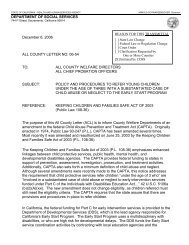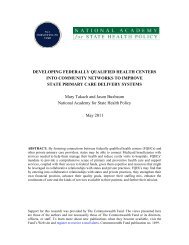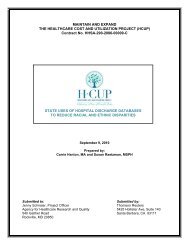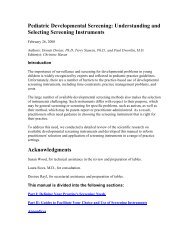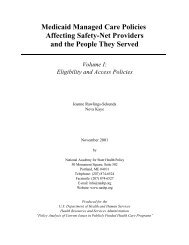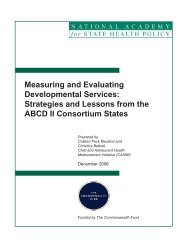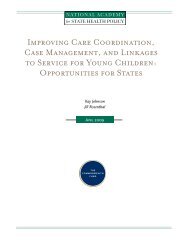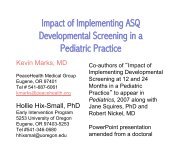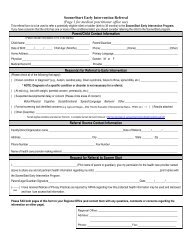Find Your Child's Developmental Age - National Academy for State ...
Find Your Child's Developmental Age - National Academy for State ...
Find Your Child's Developmental Age - National Academy for State ...
You also want an ePaper? Increase the reach of your titles
YUMPU automatically turns print PDFs into web optimized ePapers that Google loves.
<strong>Find</strong> <strong>Your</strong> Child’s <strong>Developmental</strong> <strong>Age</strong><br />
Social Feeding Child’s Motor Understanding<br />
and and <strong>Age</strong> (Movement) and<br />
Emotional Nutrition Talking<br />
• At ease away from home<br />
<strong>for</strong> part of day.<br />
• Shows likes and dislikes <strong>for</strong><br />
friends, TV, activities, etc.<br />
• Works together with friends<br />
and in groups.<br />
• Knows right from wrong.<br />
• Can accept short time-outs.<br />
• May still be afraid of some<br />
things, like the dark.<br />
• May not like being away<br />
from parents.<br />
• Will play side by side with<br />
children that are the same age.<br />
• Starting to work together<br />
during play.<br />
• Success in toilet training.<br />
• Uses objects <strong>for</strong> com<strong>for</strong>t<br />
(blanket, teddy bear, etc.)<br />
• More dreams and nightmares.<br />
• Follows basic rules.<br />
• Says “no” and responds to “no.”<br />
• Plays alone with small objects.<br />
• Explores with greater distance<br />
from parents.<br />
• Requires an adult to watch <strong>for</strong><br />
safety.<br />
• Plays peek-a-boo and back and<br />
<strong>for</strong>th games with mother.<br />
• Looks <strong>for</strong> and moves<br />
familiar objects.<br />
• Explores more.<br />
• Pays more attention and<br />
interacts with family.<br />
• Enjoys parents’ voice<br />
or reading.<br />
• Begins to tell between mother<br />
and strangers.<br />
• Becomes upset when separated<br />
from mother.<br />
• Tries to feed self.<br />
• Puts objects in mouth a lot.<br />
• Can sit without help.<br />
• Plays and smiles with mother.<br />
• Can sleep through night.<br />
• Grasps with hands.<br />
• Responds to light and sounds.<br />
• Can imitate faces.<br />
• Likes to get attention by crying.<br />
• Quiets when picked up.<br />
• Looks at faces of others.<br />
• Begins to wiggle around.<br />
• Eats a variety of foods.<br />
• Needs 3 meals and 1-2 snacks<br />
everyday.<br />
• Acts appropriately at table;<br />
mealtime 15-20 min.<br />
• Able to chew most raw foods;<br />
could choke.<br />
• Feeds self with <strong>for</strong>k and spoon.<br />
• Growth slows; appetite may<br />
decrease.<br />
• Drinks from a straw.<br />
• May show independence<br />
through food.<br />
• Eats most table foods.<br />
• May go through picky stages.<br />
• Uses cup; scoops with spoon;<br />
begins using <strong>for</strong>k.<br />
• Drinks from cup/glass<br />
without help.<br />
• Uses cup 1-2 sips at a time.<br />
• Finger feeds using thumb<br />
and <strong>for</strong>efinger.<br />
• Eats more food with texture<br />
(chopped foods, mashed table<br />
foods).<br />
• May prefer to feed self.<br />
• Spoon-feeds food that have<br />
been put through a blender.<br />
• Up and down jaw movement.<br />
• Opens mouth to anticipate<br />
spoon.<br />
• Puts toys in mouth.<br />
• Mature sucking pattern.<br />
• May bite nipple with gums.<br />
• Usually less fussy, intestines<br />
going through development.<br />
• May be ready <strong>for</strong> spoon<br />
by 4-6 months.<br />
• Instinctive feeding and sucking.<br />
• Breast milk (or <strong>for</strong>mula)<br />
is total diet.<br />
• Needs to feed every<br />
1.5 to 2 hours.<br />
• Stomach and intestines<br />
immature; can’t handle other<br />
foods.<br />
5 Years<br />
2 1/2 - 4 Years<br />
1 1/2 - 2 Years<br />
9 Months -1 Years<br />
6 Months<br />
3 Months<br />
Birth<br />
• Stands on 1 foot <strong>for</strong> 10 secs.<br />
• Jumps 10” hurdle.<br />
• Bounces and catches a ball.<br />
• Skips.<br />
• Drop kicks a ball.<br />
• Walks on balance beam.<br />
• Wants to be like adults; helps<br />
with simple kitchen tasks.<br />
• Copies four-letter words.<br />
• Builds a six-block design.<br />
• Buttons, zips, and ties.<br />
• Jumps.<br />
• Stands on 1 foot.<br />
• Hops.<br />
• Catches a ball.<br />
• Rides a tricycle.<br />
• Uses scissors.<br />
• Unbuttons.<br />
• Likes to use one hand more<br />
than the other.<br />
• Laces.<br />
• Copies shapes in drawing.<br />
• Crawls or walks up and down<br />
stairs.<br />
• Runs.<br />
• Kicks and throws ball.<br />
• Begins to climb.<br />
• Stacks toys or cubes.<br />
• Puts shapes in shape sorter.<br />
• Scribbles.<br />
• Crawls.<br />
• Claps hands.<br />
• Takes toys out of a box.<br />
• Pulls to stand.<br />
• Walks along furniture.<br />
• Walks with hands held.<br />
• Pokes finger into holes.<br />
• Can grab and hold cheerios.<br />
• Begins to put toys in or<br />
on containers or boxes.<br />
• Stands with full weight on feet<br />
with hands held.<br />
• Belly-crawls.<br />
• Sits alone using hands <strong>for</strong><br />
support.<br />
• Transfers toy hand to hand.<br />
• Shakes and bangs toys.<br />
• Grasps toes.<br />
• Rolls.<br />
• Pushes upon <strong>for</strong>earms on<br />
tummy.<br />
• Rolls from back to side.<br />
• Reaches and grasps toys,<br />
blanket.<br />
• Sits with support.<br />
• Lifts head and turns to both<br />
sides laying on tummy.<br />
• Can hold head up briefly.<br />
• Stiffens legs to stand on feet.<br />
• Grasps briefly.<br />
• Brings hands to head and face.<br />
• Says all sounds correctly except<br />
perhaps r, s, and th.<br />
• Hears and understands most<br />
speech in the home.<br />
• Can answer questions about<br />
past, present, and future events.<br />
• Says most sounds except<br />
perhaps r, s, th, l, and blends.<br />
• Can repeat sentences made up<br />
of 12 syllables.<br />
• Uses 200-300 words.<br />
• Uses 2-3 word sentences.<br />
• Asks lots of “why” and “what”<br />
questions.<br />
• Uses the sounds p, b, t, d, w, h,<br />
n, m, & ya, correctly.<br />
• Has 10-15 words at 18 months.<br />
• Uses 1-2 word questions<br />
(“Where kitty?, Go bye-bye?,<br />
More?”).<br />
• Puts 2 words together (“more<br />
cookie”).<br />
• Says 2-3 words at age 1.<br />
• Uses jargon (babbling that<br />
sounds like real speech).<br />
• Enjoys listening to people<br />
talking.<br />
• Listens to simple commands.<br />
• Stops an activity when “no no”<br />
is said.<br />
• Waves goodbye.<br />
• Points to objects.<br />
• Back and <strong>for</strong>th sharing of<br />
sounds.<br />
• Makes lots of different sounds.<br />
• Responds to name.<br />
• Notices and looks around when<br />
hearing new sounds.<br />
• Turns head toward the side<br />
where the sound is<br />
coming from.<br />
• Smiles when spoken to.<br />
• Seems to know parent’s voice.<br />
• Cries differently <strong>for</strong> different<br />
needs.<br />
• Repeats the same sounds a lot.<br />
• Startles or cries at noises.<br />
• Awakens at loud sounds.<br />
• Makes cooing and throaty<br />
sounds “gu.”<br />
• Makes sucking sounds.<br />
• Makes pleasure sounds which<br />
consist of soft vowels.
and <strong>Developmental</strong> Disabilities<br />
Utah<br />
Registry of Autism<br />
• All in<strong>for</strong>mation collected by<br />
URADD is protected from disclosure<br />
as provided in Chapter 3 of the<br />
Utah Health Code.<br />
■ Tell parents and families about<br />
resources <strong>for</strong> people who have ASDs.<br />
■ Teach health care providers and<br />
teachers how to tell if a child has an<br />
ASD.<br />
■ Help more people know about ASDs<br />
and other DDs.<br />
■ Help in the search <strong>for</strong> possible causes<br />
and treatments of ASDs and other DDs.<br />
■ <strong>Find</strong> out how many people in Utah<br />
have ASDs and other DDs.<br />
* What will URADD do?<br />
We want to include anyone in Utah who<br />
has been diagnosed with an ASD! To be a<br />
part of URADD, you simply fill out and<br />
send us the registration <strong>for</strong>m (see back).<br />
Who Should be Part of URADD?<br />
URADD’s registration <strong>for</strong>m is available at<br />
our website or it can be sent to you.<br />
http://www.health.utah.gov/autism<br />
Telephone: (801) 584-8547<br />
Toll Free: (800) 829-8200 Ext. 1<br />
Fax: (801) 584-8579<br />
URADD Investigators:<br />
Dr. Judy Pinborough Zimmerman<br />
Children with Special Health Care Needs<br />
Utah Department of Health<br />
44 N. Medical Drive<br />
Salt Lake City, Utah 84114<br />
Dr. William McMahon<br />
University of Utah School of Medicine<br />
Department of Psychiatry<br />
50 N. Medical Drive<br />
Salt Lake City, Utah 84132<br />
Email:<br />
URAAD@utah.gov<br />
Mailing Address:<br />
Utah Registry of Autism and<br />
<strong>Developmental</strong> Disabilities<br />
Utah Department of Health<br />
PO Box 144643<br />
44 North Medical Drive<br />
Salt Lake City, Utah 84114-4643<br />
▼ Open this brochure to see more about<br />
normal development.<br />
Understanding ASDs and other DDs<br />
helps researchers find causes and<br />
treatments <strong>for</strong> these conditions.<br />
The goal of this network is to better<br />
understand how many people have ASDs<br />
and other DDs in all parts of the country.<br />
URADD is part of the Centers <strong>for</strong> Disease<br />
Control and Prevention network of states<br />
studying ASDs and other DDs.<br />
* URADD is Part of a <strong>National</strong> Network<br />
URADD is a project to study how many<br />
children or people with ASDs and DDs are<br />
in Utah over time.<br />
What Is the Utah Registry of Autism and<br />
<strong>Developmental</strong> Disabilities (URADD)?<br />
Utah Registry of Autism and<br />
<strong>Developmental</strong> Disabilities<br />
44 North Medical Drive<br />
P.O. Box 144643<br />
Salt Lake City, Utah 84114-4643<br />
and <strong>Developmental</strong> Disabilities<br />
Utah<br />
Registry of Autism<br />
The way they act is unusual and inflexible.<br />
They may become upset if routines<br />
change.<br />
* Restricted or repetitive behavior<br />
About four out of 10 children who have an<br />
ASD do not speak at all. Others only repeat<br />
what they hear.<br />
* Unusual ways of communicating<br />
People with an ASD have problems understanding<br />
other people’s feelings. They may<br />
not look you in the eye or they seem to be<br />
“in their own world.”<br />
* Problems relating to other people<br />
Each person who has an ASD is unique.<br />
Some have very mild symptoms while others<br />
have more severe symptoms. Symptoms<br />
include:<br />
They are developmental disabilities that<br />
affect the way a person acts.<br />
* What are Autism Spectrum<br />
Disorders? (ASDs)?<br />
<strong>Developmental</strong> Disability (DD) means that a<br />
child has not learned basic skills or cannot<br />
do certain things when they should.<br />
What is a <strong>Developmental</strong> Disability?<br />
Utah Registry<br />
of Autism and<br />
<strong>Developmental</strong><br />
Disabilities<br />
Utah Department of Health<br />
Utah<br />
Registry of Autism<br />
and <strong>Developmental</strong> Disabilities



